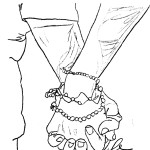Cortisol, the stress hormone, is released as part of a the Fight or Flight response. You’ve probably heard the story: back when we were huntering and gathering, when faced with a wild, sabor-toothed tiger, adrenaline was released, our blood vessels dilated, our hearts beat faster, our breath became rapid, blood was directed from our digestive organs to our muscles and we prepared ourselves to either confront the hairy beast or head for the hills (or up a tree)!
Now, instead of sabor-toothed tigers, we have exams, deadlines, tension-filled family dinners, presentations to give and blog articles to write. Instead of experiencing the Stress Response for a fleeting moment, we experience it continuously throughout our professional lives.
During a normal, healthy day, cortisol is high in the morning, when we wake up. This enables us to feel awake and leap out of bed with the bright-faced vigor of the hated “morning person”. It enables us to start our daily activities. Cortisol should level off throughout the day and then peter off right before bed time, as we digest our dinners, cuddle with loved ones before the fire and prepare to settle down for a nice, long sleep.
Unfortunately, that’s the picture of a balanced individual living in a stress-free world. In today’s world, because we are continuously living in sabor-toothed tiger-mode, our normal cortisol cycle is out of whack. Cortisol is sluggish in the morning when we haul ourselves out of bed (after hitting the snooze as many times as you can remember) and groggily start our day (with the help of the beloved espresso machine). In the afternoon we crash; we feel tired and useless all day long. Then, right before bed (I’m sure many of you have experienced this), we feel an energy we never thought possible. At 11pm we experience a cortisol high, characterized by a flurry of mental and physical activity, and find it impossible to fall asleep. It is common to hear people who suffer from chronic fatigue lament: “I wish I was as energetic throughout the day as I am at bedtime!” Of course, the harder it is for us to get to sleep, the less we sleep and the worse we feel in the morning, worsening the cycle.
Here are some tips to attempt to break the cycle and prepare the body for bedtime:
1) Eliminate non-sleep activity in the bedroom. Reserve your bed and, preferably bedroom, for sleep and sex. Studying and doing work on your bed confuses the psyche. Only entering the bed when it’s time for sleep, signals to the brain that it’s time to rest.
2) Keep the bedroom dark. Even a minimal amount of light can lower melatonin levels, an important sleep hormone, and make it harder to fall asleep.
3) Limit the exposure to electronics (laptops, television, smart-phones, etc.) 1-2 hours before bedtime. Not only does the light from these devices interfere with melatonin secretion, they also contribute to the secretion of cortisol by stimulating mental activity and, if the activity is work-related, generating stressful thought.
4) Begin a pre-sleep routine. It can be a simple meditation or a series of calming yoga poses (try “legs up the wall pose”, pictured below). You may simply choose to sit quietly in the dark. When I have trouble falling asleep I access an audio podcast meditation on meditationoasis.com. This helps me turn off the Fight or Flight response by calming my mind.
5) Consider magnesium supplementation. Magnesium is a natural muscle relaxant. Taking a dose before bedtime helps reduce the muscle tension we have built-up over the course of our stressful day and helps relax the body and prepare for restful sleep. Talk to your naturopathic doctor about correct dosing and to find out whether supplementing with magnesium is suitable for you.
6) Sleep like Buddha. According to Ayurvedic medicine, as taught in my continuing education course with Matthew Remski, the right side of the body is the Solar Side, and the left side the Lunar side. Before bed the left nostril should be more open than the right, indicating that our left, or lunar, side is more active. Try lying on your right side and, with your right pinky, block your right nostril. Breath through the left nostril for 15 minutes. You may find that your left nostril feels “stuffy” at first. This tells you that your lunar side has not yet been activated. Continue breathing only through the left nostril and you will find that, after a small amount of time, it begins to unblock and becomes the more active nostril. In the East, all statues of sleeping Buddha show him lying on his right side with his right hand under his head, as he shuts down his solar side and prepares for sleep.
In the morning you may want to try blocking the left nostril and breathing only through the right in order to activate your solar side as you begin the day.
*This article is not meant to diagnose or treat. Please visit a trained naturopathic doctor for an individual consultation and treatment plan tailored to your individual needs.







Thanks for this! The “legs up the wall” pose helps as well when awaken during night and having trouble to fall asleep again. It works wonders 🙂
Thanks for reading and commenting!